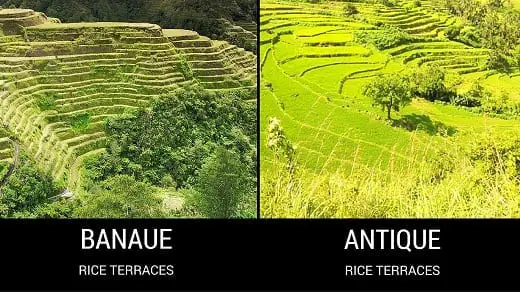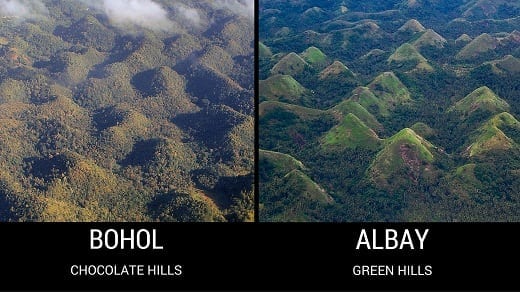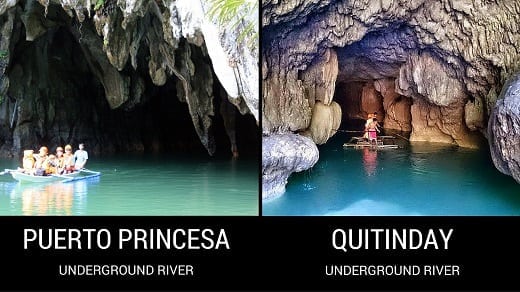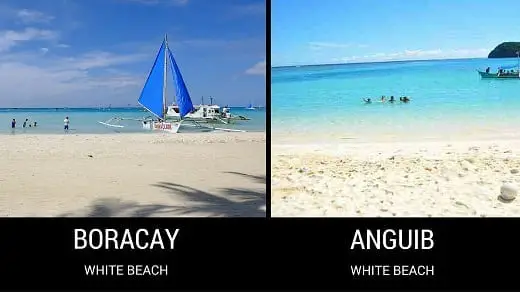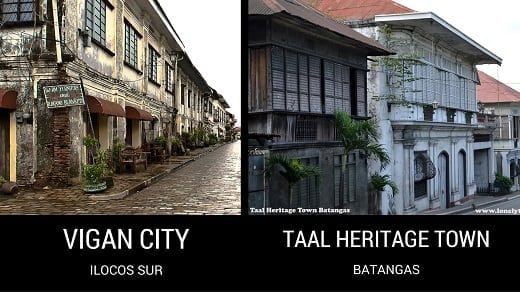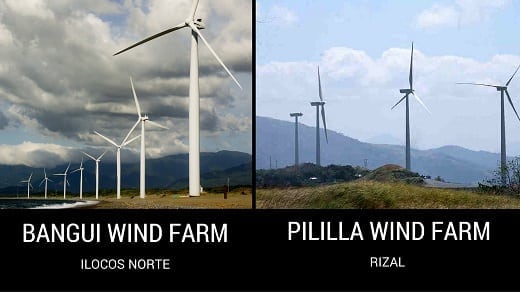7 Unbelievable Look-Alikes of Famous Pinoy Tourist Spots
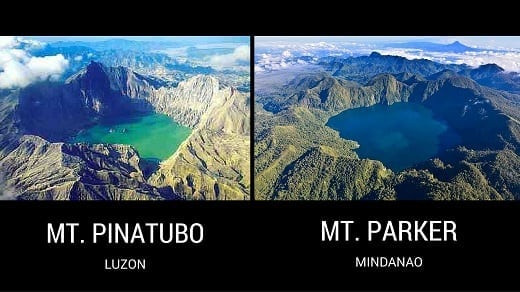
While genetics may have something to do with total strangers who are carbon copies of each other, the same cannot be said for landmarks. In the Philippines, for instance, it is either nature or mere coincidence that gave birth to some of the most unbelievably identical tourist spots ever known.
As time went by, the hidden, lesser-known landmarks have been overshadowed by their world-famous counterparts. But that doesn’t mean they’re not worth checking out; in fact, one visit is enough to prove that their obscurity is offset by their overflowing awesomeness. This list will prove that.
Also Read: 8 Hidden Paradises in the Philippines That Will Take Your Breath Away
1. Banaue Rice Terraces versus Antique Rice Terraces
There are few natural wonders as breathtaking as the rice terraces of the Ifugao province. Dubbed as the “8th Wonder of the World,” the terraced rice paddies were carved to perfection 2,000 years ago by the early Ifugao people.
This man-made marvel, equipped with an ancient irrigation system, is a testament to man’s harmony with nature. And for a while, we believed it’s the only existing terraced rice field in the country. Or so we thought.
When Emmanuel Lerona of UP Visayas was browsing Google Earth’s 3D virtual map in early 2014, he was expecting to see forest areas. But nothing could have prepared him for what he stumbled upon that day: a cluster of rice terraces hidden from view by three mountains in the San Remigio town in Antique province.
The hidden gem, as it turned out, is owned and being maintained by the local indigenous group called Iraynon-Bukidnon. Prior to its “rediscovery,” the majestic landmark was rarely visited by outsiders because the nearest neighboring barangay is 18 kilometers away. And although the rice terraces have enabled them to produce four crops in a year, the Iraynons don’t sell the rice and only use it for their own consumption.
READ: 6 Scary Bridges in the Philippines You’ll Have To See To Believe
We can only hope that the Iraynons will continue to sustain the untouched beauty of Antique’s rice terraces. As for its counterpart in the north, the continuous migration of younger Ifugaos to urban areas and their aversion to farming have led the iconic structure into a state of deterioration. So much has changed in Banaue Rice Terraces that it has been on the list of “World Heritage in Danger” since 2001.
2. Chocolate Hills of Bohol versus Green Hills of Albay
We associate Bohol with either tarsier or the world-famous Chocolate Hills. The latter is so named because the grass covering these dome-shaped limestone hills turns brown during the dry season, making them look like giant Hershey’s Kisses. Most of the time, however, these iconic hills look like anything but chocolate.
It is during these times when they are covered by lush green grass that we are reminded of another landmark in a province more famously known for its perfectly-formed volcano–the Green Hills” of Albay.
Also Read: 27 Things You’ll Only See in the Philippines
The said rolling hills, also known as Quitinday Green Hills Formation Reserve, is a less-explored geological treasure located in Barangay Quitinday in the town of Camalig. They may not be as symmetrical as their counterparts in Bohol, but Albay’s “Green Hills” is the closest thing to Chocolate Hills that nature lovers can explore.
The Green Hills–sometimes referred to by locals as “Pili Nut Hills” (named after Bicol’s famous product)– is located approximately 15 kilometers from the town center. Other things you can try or visit in Camalig are Hoyop-Hoyopan Cave, the Japanese war tunnels in Mt. Kitwinan, the spicy local delicacy called pinangat, and the 17th-century Church of St. John the Baptist.
3. Puerto Princesa Underground River versus Quitinday Underground River
Its inclusion on the list of New 7 Wonders of Nature needs no explaining. Puerto-Princesa Subterranean River National Park, or simply Puerto Princesa Underground River, leads tourists to one of the world’s finest and most jaw-dropping cave systems. The river is unique on its own: it flows directly into the sea and is surrounded by forests where a rich ecosystem is cradled.
Unknown to many (yes, including the locals), there’s another underground river in Albay waiting to be explored. Known as the Quitinday Underground River, it is the only underground river in the Bicol region. It pierces through the Naglaus Cave which is located at the heart of Barangay Quitinday in the town of Jovellar in Albay. Note that this is different from Barangay Quitinday in Camalig where you can find the Green Hills (see #2).
Also Read: 9 Interesting Facts You Might Not Know About Batanes
The cave and the underground river are surrounded by nature, making it a perfect spot for those looking for a place to unwind. The bats and deep, crystal clear water inside the cave can be accessed through a bamboo raft which carries up to 5 persons.
For only 20 pesos per head, one can already explore the cave’s stunning stalagmites and stalactites. A breathtaking beauty similar to Puerto Princesa’s–only a little bit cheaper.
4. Boracay White Beach versus Anguib White Beach
It didn’t earn the title “Boracay of the North” for no reason. Located at Barangay San Vicente in the town of Sta. Ana in Cagayan, the Anguib Beach is hands down the most deserving of the title among the places who claim as such.
But while Boracay’s 4-kilometer white beach is now dotted by restaurants, bars, and hotels brimming with local and foreign tourists, the hidden paradise of Cagayan begs to differ. Few tourists visit the place since Anguib requires up to 17 hours of travel from Manila. But the long travel time is definitely worth it; apart from a peaceful ambiance, the beach heaven is surrounded by hills and tall trees.
Aside from Anguib Beach, Sta. Ana in Cagayan is also home to another must-see place for adventure-seekers: the Palaui Island. No less than reality TV show “Survivor” selected it as their filming location in 2013. So if you’re looking for unspoiled alternatives to Boracay, Cagayan’s Anguib and Palaui are the places worth checking out.
Related: How to Unwind on Kalanggaman Island in Leyte: The Ultimate Travel Guide
5. Vigan City versus Taal Heritage Town
While we keep tearing down heritage sites in Manila, those in Vigan have brought heritage preservation to the next level. As a result, this old Philippine town easily made its way on the list of New 7 Wonder Cities of the World.
Visiting Vigan is like traveling back in time. The town is so old that its origin can be traced to as far back as the 16th century when Chinese merchants arrived in Isla de Bigan to trade their goods in exchange for gold and other native products.
But if you’re short of time and money, no need to fret. A few hours from Manila, more than 180 ancestral houses in what has been dubbed as the “Little Vigan of the South” await history buffs and travel junkies alike.
The place? None other than Taal town which is only an hour’s drive from Tagaytay.
Among the must-see buildings that evoke nostalgia in this historic town is the Baroque-style Basilica of San Martin de Tours. Known as the largest Catholic church in Asia, this National Historical Landmark was built by Luciano Oliver–the same architect behind Manila Cathedral’s majestic design.
Other places worth-visiting include Casa Villavicencio, home of revolutionary heroine Gliceria Marella Villavicencio; Villa Tortuga, a restaurant-cum-photo studio where you can taste local delicacies and take a portrait of yourselves while wearing 19th-century Philippine costumes.
6. Mount Pinatubo of Luzon versus Mount Parker of Mindanao
The 1991 cataclysmic eruption of Mt. Pinatubo exists in our memory as one of the most unforgettable events of the 20th century. But today, decades after it spewed aerosols that brought long-term climate changes, the stratovolcano attracts thousands of tourists and adventure seekers.
One of its attractions is the alluring and postcard-perfect Lake Pinatubo, formed by the volcano’s explosive eruptions in 1991. The crater-lake is also considered as the deepest lake in the country.
Also Read: Mt.Pinatubo’s Eruption Aftermath, As Seen From Space
Another stunning yet lesser-known crater-lake in the country, the Lake Holon, is nestled in what most people describe as Mount Pinatubo’s counterpart in Mindanao–Mount Parker. Locally known as Mt. Melibingoy, this active stratovolcano is a promising tourist magnet in T’boli, South Cotabato. It earned its other name, Mt. Parker, when an American pilot crashed in the mountain and people decided to name it in his honor.
Both Mt. Parker and Mt. Pinatubo share a lot of things in common, so much so that Dr. Renato Solidum of Phivolcs (Philippine Institute of Volcanology and Seismology) called them “twins.” This is because of their similarities “in terms of characteristics and chemical composition of their rocks and magma.”
And since both are stratovolcanoes, Solidum also warned that the possible eruption of Mt. Parker in the future might bring damaging effects to nearby provinces with the same magnitude as the Mt. Pinatubo eruption.
7. Bangui Wind Farm versus Pililla Wind Farm
We usually see the giant windmills of Ilocos Norte on our friends’ Instagram-worthy jump shots. However, the purpose of the Bangui Wind Farm is far greater than its reputation as a top tourist attraction.
As the first wind farm in the country (it started its operations in 2005), the Bangui Wind Farm has provided as much as 40% of the power needed by the province. And because it helps reduce people’s electric bills and produces no pollution or greenhouse gases, it has proven that the use of alternative energy can pay off in the long run.
Soon, other provinces followed suit.
In the town of Pililla in Rizal province, for instance, 27 wind turbines–bigger than their counterparts in the north–are now providing the province and Metro Manila with clean energy. The $100-million project, which started during the incumbency of former Rizal Governor Casimiro “Junjun” Yñares III, is expected to shorten the number of hours with no electricity during rotational brownouts.
Related Article: 10 of the Most “Imeldific” Things Imelda Marcos Ever Did
The location of the windmills is also seen as a huge help in drawing more tourists to Pililla. Not only does it provide visitors with a perfect view of the Laguna Lake and other Rizal municipalities, but it is also two-hour drive away from Manila which makes it an ideal choice for a getaway.
References
ABS-CBN,. (2015). Quitinday Underground River. Retrieved from https://goo.gl/otmjVW
ABS-CBN,. (2015). Taal town tagged ‘little Vigan of the south’. Retrieved from http://goo.gl/bnemP4
Calawag, F. (2015). Rice terraces ‘rediscovered’ in Antique. Inquirer.net. Retrieved 27 November 2015, from http://goo.gl/xF6Vao
Cinco, M. (2015). Rizal wind farm rises to supplement energy. Inquirer.net. Retrieved 28 November 2015, from http://goo.gl/mZpNba
del Mundo, I. (2015). Albay’s unexplored Camalig. philSTAR.com. Retrieved 27 November 2015, from http://goo.gl/HHQtNc
Jimeno, J. (2007). Harnessing the wind. Philippine Center for Investigative Journalism. Retrieved 28 November 2015, from http://goo.gl/OL1QcQ
Lonely Planet,. Introducing Boracay. Retrieved 28 November 2015, from http://goo.gl/aqdkSK
MindaNews,. (2014). Phivolcs warns of Pinatubo-like eruptions in SouthCot, Sarangani. Retrieved 28 November 2015, from http://goo.gl/iPt4gy
National Geographic Traveler,. (2012). Mt. Melibingoy (Mt.Parker) Crater lake, T’boli South Cotabato. Retrieved 28 November 2015, from http://goo.gl/yEZUoP
National Geographic,. Philippine Rice Terraces. Retrieved 27 November 2015, from http://goo.gl/PbyIb
Philippine Statistics Authority,. (2012). Facts & Figures: Ifugao Province At A Glance. Retrieved 27 November 2015, from http://goo.gl/RkgE0p
philSTAR.com,. (2014). Boracay of the north. Retrieved 28 November 2015, from http://goo.gl/AjBphm
Ramirez, J. (2015). Taal: Vigan of the South. philSTAR.com. Retrieved 28 November 2015, from http://goo.gl/Cp0uCp
UNESCO World Heritage Centre,. Puerto-Princesa Subterranean River National Park. Retrieved 28 November 2015, from http://goo.gl/WdDlzG
WOWLegazpi.com,. Quitinday Green Hills Nature Park, Camalig. Retrieved 27 November 2015, from http://goo.gl/3KVHJM
FilipiKnow
FilipiKnow strives to ensure each article published on this website is as accurate and reliable as possible. We invite you, our reader, to take part in our mission to provide free, high-quality information for every Juan. If you think this article needs improvement, or if you have suggestions on how we can better achieve our goals, let us know by sending a message to admin at filipiknow dot net
Copyright Notice
All materials contained on this site are protected by the Republic of the Philippines copyright law and may not be reproduced, distributed, transmitted, displayed, published, or broadcast without the prior written permission of filipiknow.net or in the case of third party materials, the owner of that content. You may not alter or remove any trademark, copyright, or other notice from copies of the content. Be warned that we have already reported and helped terminate several websites and YouTube channels for blatantly stealing our content. If you wish to use filipiknow.net content for commercial purposes, such as for content syndication, etc., please contact us at legal(at)filipiknow(dot)net
